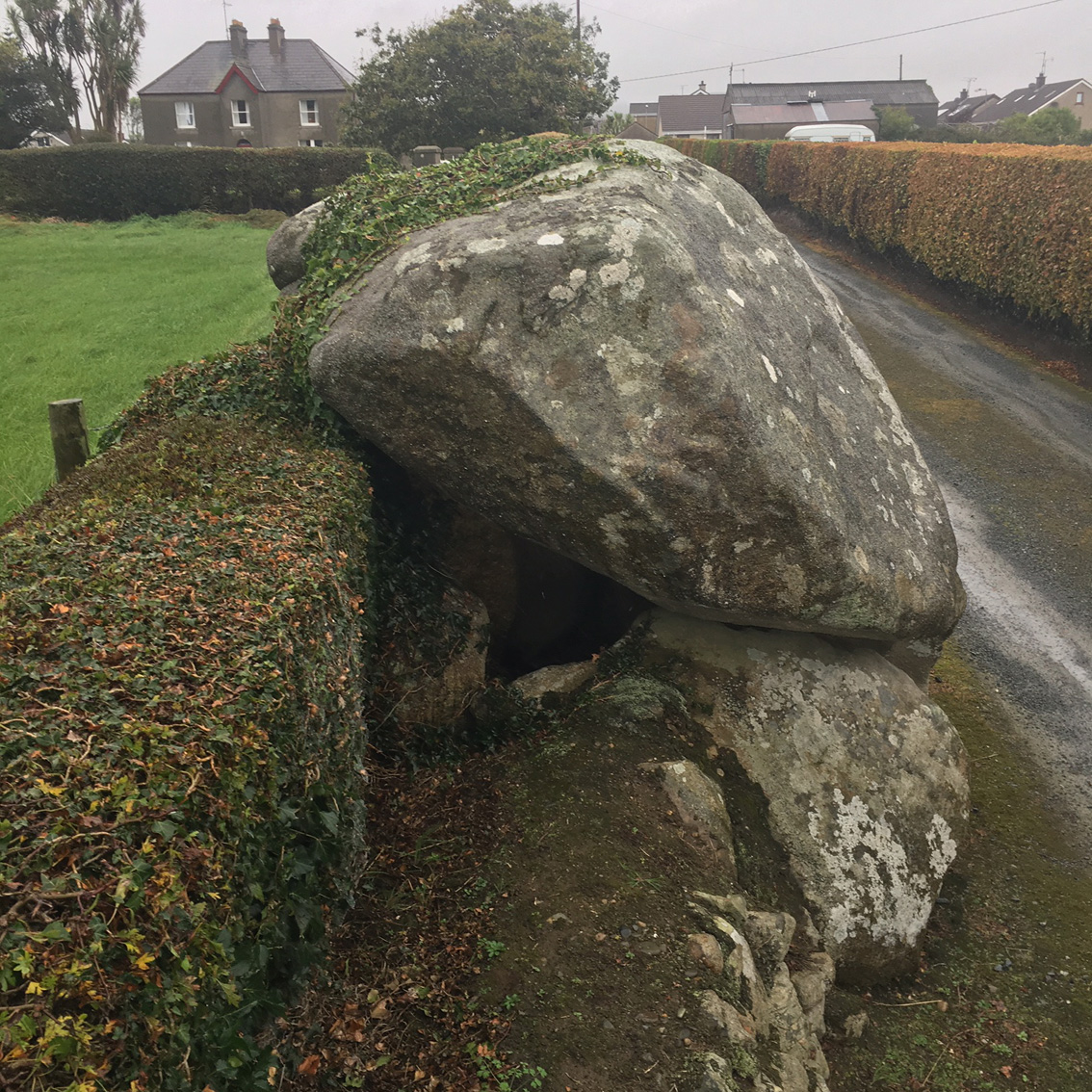
From this angle it looks like it is trying to scamper over the wall, maybe to get away from the locals...

From this angle it looks like it is trying to scamper over the wall, maybe to get away from the locals...

Most, if not all, of the main stones are still extant, though the capstone may have slipped somewhat.



I had an appointment in a hotel in Letterkenny and it finished earlier than I had expected. Usually if I’m traveling that far I’ll have done an itinerary and have my maps with me, but as I thought I’d be in the hotel until nightfall, I hadn’t bothered. Now I had about 2 and a half hours of daylight to spare so I typed in Drumskinny stone circle into Google Maps and headed off. It was 50 minutes away and was going to add 30 minutes to my three hour journey home but what the hell.
I headed out the Letterkenny to Ballybofey road but was traveling almost blind as I’d never been in this part of the country. I kept pretty much to the GM directions but peered over any hedgerows I could to see if there were any wayward sites. After about 25 minutes and heading downhill towards some forestry I noticed a bunch of upright stones beside a field wall about 50 metres into a field on my left. I was fairly moving it but jammed on a bit past and out of sight of the site. The speed limit sign I parked beside was in mph and as I left the car and headed back, there was one in kph – I was right on the border.
The border-line runs right through this tomb. It is not mentioned in the Survey of the Megalithic Tombs of Ireland, Vol. VI, County Donegal but is mentioned in the Archaeological Inventory of County Donegal. It is very much a court tomb and is a wrecked mess that could do with a bit of tidying up. The remains of the court lie mostly in Donegal but most of the tomb, with an ante-chamber, a full chamber entranced through a classic pair of jambstones and a completely destroyed sub-chamber are in Tyrone. Indeed, the only online mention I can find for this calls it Garvagh, and places it in that townland in Tyrone. It’s mentioned in the inventory section of Tomb Travel, the Northern Ireland Environment Agency SMR number TYR 015:005.


A most peculiar arrangement of stones, and right beside the road, much to my surprise.

Further to Greywether’s reference above:
From Irish Passage Graves, Neolithic Tomb-Builders in Ireland and Britain 2500 B.C. by Michael Herity
Dw. 6
ANNADORN TD.
Cromlech (1835)
Sheet 30
A rectangular chamber 1.8m across covered by a capstone is all that remains of a chamber approached from the north-east by a lintelled passage, which originally stood under a round cairn 18m in diameter. It stands about 46m (150’) O.D.
Dubordieu, writing in 1802, described it as ‘having been discovered, nearly 30 years ago, to contain within its circumference, which is about 60 yards, and towards the bottom, a large smooth stone, of a square figure, from seven to eight feet over, and supported by several other stones above three and a half feet high, forming underneath a kind of chamber, in which were found ashes, and a number of bones to appearance human; upon the surface of this large stone, when the smaller stones which were pyramidically arranged were removed, a quantity of black ashes were found. The entrance to this chamber was towards the north, and under several flat stones regularly disposed in front of each other, and extending to the outside of the cairn; these stones were some years ago taken away for building.‘
Dubordieu 1802, 270; ASNI, Down, 78; Prelim. Survey 103; Borlase, vol. I, 286; Ó Nualláin 27.




There are many outliers at Ballynnoe, leading one to speculate about alignments and such.



The remains of the court are in Donegal in the south but are north of the rest of the tomb which is in Tyrone, north of the border but south of the court.

This tomb is a mess, with a so-called international border running right through it.








Page shows plan and photo of uncovered wedge tomb.

Usna wedge tomb on the fairway of Carrick-on-Shannon golf course.

A mound on a golf course containing a wedge tomb. It is there and was excavated.


A bit dubious about this one. Not in the 1972 published Survey of the Megalithic Tombs of Ireland.


From above the back of the tomb, after a serious clean-up.


The cairn was altered in 1918 to mark the occasion of the election of the Irish nationalist Count Plunkett to the first Dáil (parliament).





The tomb is in a forest just west of Keadew town, a place that prides itself on its tidiness. It’s signposted off the circular trail that runs though the forest and this trail is obviously looked after. However, the fallen tree that covers the chamber and the general air of disarray around the tomb is a bit of a let-down, given the thoughtfulness that prevails in the locality.

Some of the stones at the back of the chamber. The rest are under the fallen tree.



Taken from the south – the gallery is destroyed and all that remains are the visible backstone to the left of the shot, and three court stones buried under the brambles.

This is the backstone of the court tomb and along with 3 court stones in the brambles are all that remains of the monument.


The nearby court tomb would be intervisible were there not trees and buildings in between.

The basin is quite shallow on the near side and is carved into the slope of the stone.

There is a children’s burial ground and a mass rock in trees in the background.
